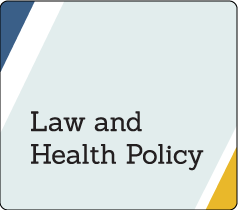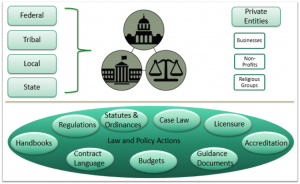This content was part of the Healthy People 2020 Law and Health Policy project, which ended in 2020.
Healthy People 2020 Law and Health Policy Project Webinar Summary
The Healthy People 2020 Law and Health Policy Project webinar held on April 25, 2019 — How Legal and Policy Levers Can Amplify Efforts to Reach Healthy People Goals — examined a framework to help understand legal and policy tools that may be available to communities and stakeholders for use in efforts to reach Healthy People objectives.The webinar featured the following presentations:
Carter Blakey, Deputy Director of the Department of Health and Human Services (HHS) Office of Disease Prevention and Health Promotion (ODPHP) and Director of the Division of Community Strategies, gave an overview of the Healthy People Initiative and the Law and Health Policy Project. She also explored the roles that legal and policy strategies have played in advancing public health.
Lindsay Wiley, JD, MPH, Director of the Health Law and Policy Program at American University’s Washington College of Law and coauthor of the most recent edition of Public Health Law: Power, Duty, Restraint, provided an overview of the public health law and policy tools framework and examples of how these tools impact health.
Jennifer Ibrahim, PhD, MPH, Dean of Academic Affairs and Associate Professor at Temple University’s College of Public Health and Associate Director of the Center for Public Health Law Research, shared practical examples of how states and communities have inventoried their public health laws and used legal and policy tools to address pressing public health challenges.
About Healthy People and the Law and Health Policy Project: Carter Blakey, ODPHP
For several decades, Healthy People has been providing science-based national objectives and ambitious 10-year targets for improving the health of the nation. In this way, the initiative serves as a roadmap for health promotion and disease prevention efforts. It provides a way to understand where we are now, planning for where we need to be, and providing guidance on how to get there over the next ten-year period of time.
The Law and Health Policy Project was a collaboration between ODPHP, the Centers for Disease Control and Prevention (CDC), the CDC Foundation, and the Robert Wood Johnson Foundation (RWJF). It aimed to improve the health of communities through sharing information about evidence-based law and policy interventions. The project examined the relationship between population health and these interventions — specifically, how law and policy could be useful tools to improve health and reach the targets for specific Healthy People objectives.
Law and Health Policy Resources and Activities:
- In-depth topic-specific reports
- Bright Spots, which showcase ways legal and policy interventions can improve health in communities
- Webinar series highlighting legal and policy research and approaches to address public health
- Resources to support the development of Healthy People 2030
Role of Laws and Policies in Promoting Health and Achievement of Healthy People Objectives: Carter Blakey, ODPHP
The use of legal and policy approaches to advance Healthy People objectives has been a part of the initiative since its inception, and the Secretary’s Advisory Committee on National Health Promotion and Disease Prevention Objectives for 2030 (Committee) specifically explored the potential role of law and policy in Healthy People 2030, the next iteration of the initiative. In an issue brief focused on law and policy, the Committee conceptualized law and policy as determinants of health, explaining that they can serve as the structural engineers that shape conditions in areas that impact population health outcomes, like education and housing.
Many law and policy activities and actions can influence health—for example, statutes, ordinances, regulations, case law, and even institutional policies. They can be adopted and influenced at multiple levels of government: federal, state, tribal, local, and organizational (See Figure 1). In addition, each branch of government—whether executive, legislative, or judicial—has a unique role in shaping the impact of laws and policies in ways that can both help and hinder progress toward Healthy People objectives.
It is also important to recognize that shaping laws and policies is a continuous process. Specific problems are identified, and leaders and communities develop ideas to try to solve them. Some of these ideas can be enacted, adopted, or advanced through legal and policy actions. Once enacted or adopted, they must be implemented and enforced. Additionally, it is critical to evaluate laws and policies just like any other public health intervention to see whether a specific law or policy is having its desired impact, needs to be changed or updated, or is causing unintended consequences. This evaluation analysis can occur at any point along this continuum (see Figure 2). Evaluation can serve a particularly critical function in addressing health equity and ensuring that all populations benefit from using legal and policy tools to improve health and well-being.
Figure 2: Evaluation of Laws and Policies
The combination of the variety of law and policy actions and potential intervention points means that a leader or community may have many legal and policy options to address a public health issue. Different communities may use different approaches to achieve similar goals. For example, our past Law and Health Policy report shows that the Navajo Nation, New York City, and the state of Georgia all used different legal or policy tools to increase the intake of fresh fruits and vegetables.
By eliminating the sales tax on healthy foods and levying a new tax on foods with minimal nutritional value, the Navajo Nation used fiscal policy to incentive healthy food purchases—and they use the revenue from the new tax to fund public health and wellness activities. New York City created a new class of mobile vending business permits specifically for Green Carts, which only sell fresh fruits and vegetables in designated parts of the city where access to and consumption of fruits and vegetables is limited. Finally, Georgia created a voluntary designation program called Growing Fit to recognize early learning centers with organizational wellness programs that incorporate nutrition. With so many children attending day care programs, they have an important role in promoting lifelong healthy eating patterns. Two state agencies in Georgia—the Department of Public Health and the Department of Early Learning—provided resources and support to help early learning centers adopt evidence-based wellness policies. These examples are included in the Law and Health Policy Project Bright Spots, and information about their impact is available online.





